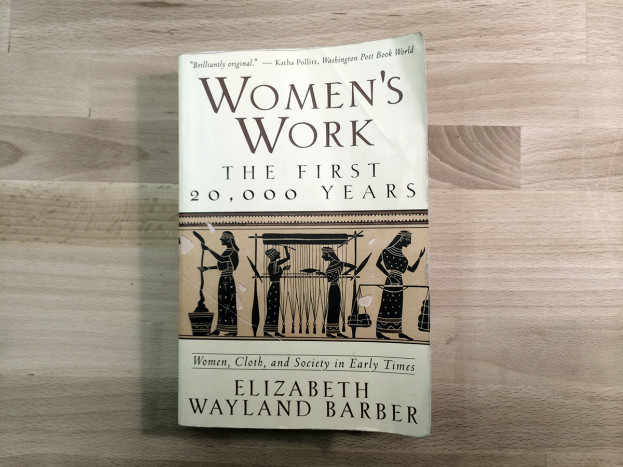Barber, E. J. W. Women’s Work: The First 20,000 Years: Women, Cloth, and Society in Early times. New York: Norton, 1994.
Textiles are relatively perishable. They cannot survive half as long as objects made of stone, iron and bronze can. Material remains have limited our knowledge about the lives of early people. In writing Women’s Work, Elizabeth Wayland Barber invents extraordinary methods to look closely at early textile practices. By focusing on textiles, which has always been a major product of women, Barber deduces information about early women’s lives, their work and their values.
The string, we are told, was invented sometime between 20,000 to 30,000 years ago. We do not know when exactly it happened. “But whenever it happened,” argues Barber, “it opened the door to an enormous array of new ways to save labor and improve the odds of survival, much as the harnessing of steam did for the Industrial Revolution.”[1] What Barber calls “The String Revolution” enabled humans to catch, hold, carry, or bind things in order to make more complex objects, leading the string to become “the unseen weapon that allowed the human race to conquer the earth.”[2] Women’s Work presents how, contrary to the common perception, the invention of string is just as important for humanity as the making of the first stone tools or the discovery of fire.
One important question posed in the book is why textiles have become the craft of women par excellence, and not of men. Barber seems to be convinced by Judith Brown’s argument in the essay “Note on the Division of Labour by Sex”[3]. According to Brown, societies have relied on women for activities such as cooking, spinning, weaving and sewing simply because those activities were compatible with the demands of childcare. Breast-feeding back then was typically continued for two or three years. Mothers, therefore, had to take on the tasks that were child safe and not so far from home, and that required relatively less concentration. Although Brown’s reasoning is sound, the discussion around this crucial question could have been expanded in the book. What is quite interesting is Barber’s reminder of how making clothing and fiber objects were extremely crucial in those societies. In other words, the two hard and time-consuming tasks, textiles and hunting, were simply distributed between women and men. Born after the Industrial Revolution, we tend to regard fiber crafts as a hobby occupation, as an activity that women do for pleasure in leisure time. We tend to forget that there were times when most of the hours of the women’s day had to be spent on producing textiles. Growing the sheep, shearing them, planting and harvesting flax, spinning their own yarn from scratch, weaving fabrics, sewing cloths, and later on even marketing any extra textiles for bringing income for the family… Allegedly, men had to help women in their heavy duties related to textiles production.
Throughout Women’s Work, Barber illustrates how women lived spinning, weaving and sewing, in early ages in various places like in the Minoan Crete, Ancient Egypt, or in Troy. She reconstructs how daily lives of women looked like by collecting evidence from unusual resources. For instance, she uses language via linguistic science, discovers the oldest vocabulary that survived from those ages and makes assumptions about the ongoing practices that involved those words. Or, she reconstructs an ancient piece of cloth on her own loom to be able to find out about the physical and cultural conditions in which that cloth had been produced, information that she thinks “no amount of armchair theorizing can give.”[4]. The methods that Barber invents are as remarkable as the stories she weaves. Women’s Work evokes a new appreciation for the evolution of textiles technology and an understanding of women and their products as an immensely powerful force in ancient economy.
[1] Women’s Work, p. 45.
[2] Women’s Work, p. 45
[3] Judith K. Brown, “A Note on the Division of Labor by Sex,” American Anthropologist, New Series, Vol. 72, No. 5 (Oct., 1970), pp. 1073-1078.
[4] Women’s Work, p. 23.
